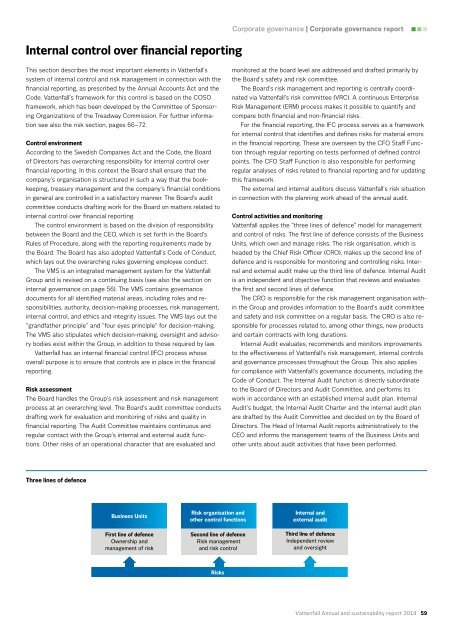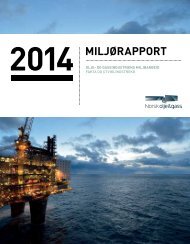annual-and-sustainability-report-2014
annual-and-sustainability-report-2014
annual-and-sustainability-report-2014
You also want an ePaper? Increase the reach of your titles
YUMPU automatically turns print PDFs into web optimized ePapers that Google loves.
Internal control over financial <strong>report</strong>ingCorporate governance | Corporate governance <strong>report</strong>This section describes the most important elements in Vattenfall’ssystem of internal control <strong>and</strong> risk management in connection with thefinancial <strong>report</strong>ing, as prescribed by the Annual Accounts Act <strong>and</strong> theCode. Vattenfall’s framework for this control is based on the COSOframework, which has been developed by the Committee of SponsoringOrganizations of the Treadway Commission. For further informationsee also the risk section, pages 66–72.Control environmentAccording to the Swedish Companies Act <strong>and</strong> the Code, the Boardof Directors has overarching responsibility for internal control overfinancial <strong>report</strong>ing. In this context the Board shall ensure that thecompany’s organisation is structured in such a way that the bookkeeping,treasury management <strong>and</strong> the company’s financial conditionsin general are controlled in a satisfactory manner. The Board’s auditcommittee conducts drafting work for the Board on matters related tointernal control over financial <strong>report</strong>ing.The control environment is based on the division of responsibilitybetween the Board <strong>and</strong> the CEO, which is set forth in the Board’sRules of Procedure, along with the <strong>report</strong>ing requirements made bythe Board. The Board has also adopted Vattenfall’s Code of Conduct,which lays out the overarching rules governing employee conduct.The VMS is an integrated management system for the VattenfallGroup <strong>and</strong> is revised on a continuing basis (see also the section oninternal governance on page 56). The VMS contains governancedocuments for all identified material areas, including roles <strong>and</strong> responsibilities,authority, decision-making processes, risk management,internal control, <strong>and</strong> ethics <strong>and</strong> integrity issues. The VMS lays out the“gr<strong>and</strong>father principle” <strong>and</strong> “four eyes principle” for decision-making.The VMS also stipulates which decision-making, oversight <strong>and</strong> advisorybodies exist within the Group, in addition to those required by law.Vattenfall has an internal financial control (IFC) process whoseoverall purpose is to ensure that controls are in place in the financial<strong>report</strong>ing.Risk assessmentThe Board h<strong>and</strong>les the Group’s risk assessment <strong>and</strong> risk managementprocess at an overarching level. The Board’s audit committee conductsdrafting work for evaluation <strong>and</strong> monitoring of risks <strong>and</strong> quality infinancial <strong>report</strong>ing. The Audit Committee maintains continuous <strong>and</strong>regular contact with the Group’s internal <strong>and</strong> external audit functions.Other risks of an operational character that are evaluated <strong>and</strong>monitored at the board level are addressed <strong>and</strong> drafted primarily bythe Board’s safety <strong>and</strong> risk committee.The Board’s risk management <strong>and</strong> <strong>report</strong>ing is centrally coordinatedvia Vattenfall’s risk committee (VRC). A continuous EnterpriseRisk Management (ERM) process makes it possible to quantify <strong>and</strong>compare both financial <strong>and</strong> non-financial risks.For the financial <strong>report</strong>ing, the IFC process serves as a frameworkfor internal control that identifies <strong>and</strong> defines risks for material errorsin the financial <strong>report</strong>ing. These are overseen by the CFO Staff Functionthrough regular <strong>report</strong>ing on tests performed of defined controlpoints. The CFO Staff Function is also responsible for performingregular analyses of risks related to financial <strong>report</strong>ing <strong>and</strong> for updatingthis framework.The external <strong>and</strong> internal auditors discuss Vattenfall’s risk situationin connection with the planning work ahead of the <strong>annual</strong> audit.Control activities <strong>and</strong> monitoringVattenfall applies the “three lines of defence” model for management<strong>and</strong> control of risks. The first line of defence consists of the BusinessUnits, which own <strong>and</strong> manage risks. The risk organisation, which isheaded by the Chief Risk Officer (CRO), makes up the second line ofdefence <strong>and</strong> is responsible for monitoring <strong>and</strong> controlling risks. Internal<strong>and</strong> external audit make up the third line of defence. Internal Auditis an independent <strong>and</strong> objective function that reviews <strong>and</strong> evaluatesthe first <strong>and</strong> second lines of defence.The CRO is responsible for the risk management organisation withinthe Group <strong>and</strong> provides information to the Board’s audit committee<strong>and</strong> safety <strong>and</strong> risk committee on a regular basis. The CRO is also responsiblefor processes related to, among other things, new products<strong>and</strong> certain contracts with long durations.Internal Audit evaluates, recommends <strong>and</strong> monitors improvementsto the effectiveness of Vattenfall’s risk management, internal controls<strong>and</strong> governance processes throughout the Group. This also appliesfor compliance with Vattenfall’s governance documents, including theCode of Conduct. The Internal Audit function is directly subordinateto the Board of Directors <strong>and</strong> Audit Committee, <strong>and</strong> performs itswork in accordance with an established internal audit plan. InternalAudit’s budget, the Internal Audit Charter <strong>and</strong> the internal audit planare drafted by the Audit Committee <strong>and</strong> decided on by the Board ofDirectors. The Head of Internal Audit <strong>report</strong>s administratively to theCEO <strong>and</strong> informs the management teams of the Business Units <strong>and</strong>other units about audit activities that have been performed.Three lines of defenceBusiness UnitsFirst line of defenceOwnership <strong>and</strong>management of riskRisk organisation <strong>and</strong>other control functionsSecond line of defenceRisk management<strong>and</strong> risk controlInternal <strong>and</strong>external auditThird line of defenceIndependent review<strong>and</strong> oversightRisksVattenfall Annual <strong>and</strong> <strong>sustainability</strong> <strong>report</strong> <strong>2014</strong> 59



